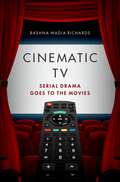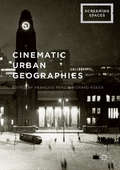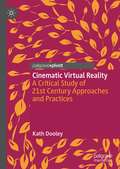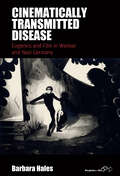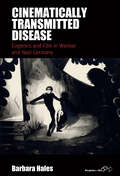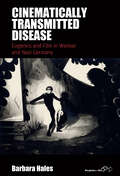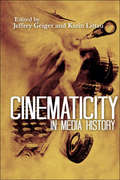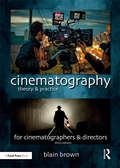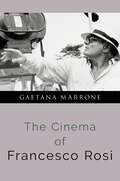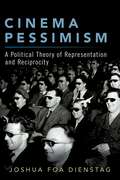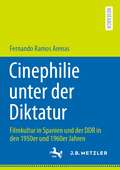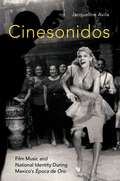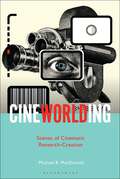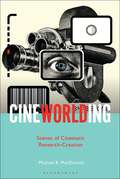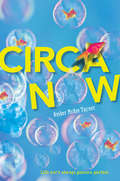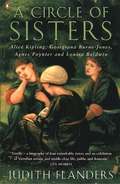- Table View
- List View
Cinematic Terror: A Global History of Terrorism on Film
by Tony ShawCinematic Terror takes a uniquely long view of filmmakers' depiction of terrorism, examining how cinema has been a site of intense conflict between paramilitaries, state authorities and censors for well over a century. In the process, it takes us on a journey from the first Age of Terror that helped trigger World War One to the Global War on Terror that divides countries and families today. Tony Shaw looks beyond Hollywood to pinpoint important trends in the ways that film industries across Europe, North and South America, Asia, Africa and the Middle East have defined terrorism down the decades. Drawing on a vast array of studio archives, government documentation, personal interviews and box office records, Shaw examines the mechanics of cinematic terrorism and challenges assumptions about the links between political violence and propaganda.
Cinematic TV: Serial Drama goes to the Movies
by Rashna Wadia RichardsFor decades after its invention, television was considered by many to be culturally deficient when compared to cinema, as analyses rooted in communication studies and the social sciences tended to focus primarily on television's negative impact on consumers. More recently, however, denigration has largely been replaced by serious critical consideration of what television represents in the post-network era. Once derided as a media wasteland, TV is now praised for its visual density and complexity. In the last two decades, media scholars have often suggested that television has become cinematic. Serial dramas, in particular, are acclaimed for their imitations of cinema's formally innovative and narratively challenging conventions. But what exactly does "cinematic TV" mean? In Cinematic TV, author Rashna Wadia Richards takes up this question comprehensively, arguing that TV dramas quote, copy, and appropriate (primarily) American cinema in multiple ways and toward multiple ends. Constructing an innovative theoretical framework by combining intertextuality and memory studies, Cinematic TV focuses on four modalities of intermedial borrowings: homage, evocation, genre, and parody. Through close readings of such exemplary shows as Stranger Things, Mad Men, Damages, and Dear White People, the book demonstrates how serial dramas reproduce and rework, undermine and idolize, and, in some cases, compete with and outdo cinema.
Cinematic TV: Serial Drama goes to the Movies
by Rashna Wadia RichardsFor decades after its invention, television was considered by many to be culturally deficient when compared to cinema, as analyses rooted in communication studies and the social sciences tended to focus primarily on television's negative impact on consumers. More recently, however, denigration has largely been replaced by serious critical consideration of what television represents in the post-network era. Once derided as a media wasteland, TV is now praised for its visual density and complexity. In the last two decades, media scholars have often suggested that television has become cinematic. Serial dramas, in particular, are acclaimed for their imitations of cinema's formally innovative and narratively challenging conventions. But what exactly does "cinematic TV" mean? In Cinematic TV, author Rashna Wadia Richards takes up this question comprehensively, arguing that TV dramas quote, copy, and appropriate (primarily) American cinema in multiple ways and toward multiple ends. Constructing an innovative theoretical framework by combining intertextuality and memory studies, Cinematic TV focuses on four modalities of intermedial borrowings: homage, evocation, genre, and parody. Through close readings of such exemplary shows as Stranger Things, Mad Men, Damages, and Dear White People, the book demonstrates how serial dramas reproduce and rework, undermine and idolize, and, in some cases, compete with and outdo cinema.
Cinematic Urban Geographies (Screening Spaces)
by Richard Koeck François PenzThis book proposes new methodological tools and approaches in order to tease out and elicit the different facets of urban fragmentation through the medium of cinema and the moving image, as a contribution to our understanding of cities and their topographies. In doing so it makes a significant contribution to the literature in the growing field of cartographic cinema and urban cinematics, by charting the many trajectories and points of contact between film and its topographical context. Under the influence of new technologies, the opening and the availability of previously unexplored archives but also the contribution of new scholars with novel approaches in addition to new work by experienced academics, Cinematic Urban Geographies demonstrates how we can reread the cinematic past with a view to construct the urban present and anticipate its future.
Cinematic Virtual Reality: A Critical Study of 21st Century Approaches and Practices
by Kath DooleyWith reference to traditional film theory and frameworks drawn from fields such as screenwriting studies and anthropology, this book explores the challenges and opportunities for both practitioners and viewers offered by the 360-degree storytelling form. It focuses on cinematic virtual reality (CVR), a format that involves immersive, high quality, live action or computer-generated imagery (CGI) that can be viewed through head mounted display (HMD) goggles or via online platforms such as YouTube. This format has surged in popularity in recent years due to the release of affordable high quality omnidirectional (360-degree) cameras and consumer grade HMDs. The book interrogates four key concepts for this emerging medium: immersion, presence, embodiment and proximity through an analysis of innovative case studies and with reference to practitioner interviews. In doing so, it highlights the specificity of the format and provides a critical account of practitioner approaches to the concept development, writing and realisation of short narrative CVR works. The book concludes with an account of the author’s practice-led research into the form, providing a valuable example of creative practice in the field of immersive media.
Cinematically Transmitted Disease: Eugenics and Film in Weimar and Nazi Germany (Film Europa #28)
by Barbara HalesPropaganda played an essential role in influencing the attitudes and policies of German National Socialism on racial purity and euthanasia, but little has been said on the impact of medical hygiene films. Cinematically Transmitted Disease explores these films for the first time, from their inception during the Weimar era and throughout the years to come. In this innovative volume, author Barbara Hales demonstrates how medical films as well as feature films were circulated among the German people to embed and enforce notions of scientific legitimacy for racial superiority and genetically spread “incurable” diseases, creating and maintaining an instrumental fear of degradation in the German national population.
Cinematically Transmitted Disease: Eugenics and Film in Weimar and Nazi Germany (Film Europa #28)
by Barbara HalesPropaganda played an essential role in influencing the attitudes and policies of German National Socialism on racial purity and euthanasia, but little has been said on the impact of medical hygiene films. Cinematically Transmitted Disease explores these films for the first time, from their inception during the Weimar era and throughout the years to come. In this innovative volume, author Barbara Hales demonstrates how medical films as well as feature films were circulated among the German people to embed and enforce notions of scientific legitimacy for racial superiority and genetically spread “incurable” diseases, creating and maintaining an instrumental fear of degradation in the German national population.
Cinematically Transmitted Disease: Eugenics and Film in Weimar and Nazi Germany (Film Europa #28)
by Barbara HalesPropaganda played an essential role in influencing the attitudes and policies of German National Socialism on racial purity and euthanasia, but little has been said on the impact of medical hygiene films. Cinematically Transmitted Disease explores these films for the first time, from their inception during the Weimar era and throughout the years to come. In this innovative volume, author Barbara Hales demonstrates how medical films as well as feature films were circulated among the German people to embed and enforce notions of scientific legitimacy for racial superiority and genetically spread “incurable” diseases, creating and maintaining an instrumental fear of degradation in the German national population.
Cinematicity in Media History (Edinburgh University Press)
by Jeffrey Geiger Karin LittauIn a world where change has become the only constant, how does the perpetually new relate to the old? How does cinema, itself once a new medium, relate both to previous or outmoded media and to what we now refer to as New Media? This collection sets out to examine these questions by focusing on the relations of cinema to other media, cultural productions and diverse forms of entertainment, demarcating their sometimes parallel and sometimes more closely conjoined histories. It makes visible the complex ways in which media anticipate, interfere with and draw on one other, demonstrating how cinematicity makes itself felt in practices of seeing, reading, writing and thinking both before and after the ‘birth’ of cinema. Examining the interrelations between cinema, literature, photography and other modes of representation not only to each other, but amid a host of other minor and major media - the magic lantern, the zoetrope, the flick-book, the iPhone and the computer - Cinematicity in Media History provides crucial insights into the development of media and their overlapping technologies and aesthetics.
Cinematography: Image Making for Cinematographers and Directors
by Blain BrownThe world of cinematography has changed more in the last few years than it has since it has in 1929, when sound recording was introduced. New technology, new tools and new methods have revolutionized the art and craft of telling stories visually. While some aspects of visual language, lighting and color are eternal, shooting methods, workflow and cameras have changed radically. Even experienced film artists have a need to update and review new methods and equipment. These change affect not only the director of photography but also the director, the camera assistants, gaffers, and digital imaging technicians. Cinematography: Theory and Practice covers both the artistry and craftsmanship of cinematography and visual storytelling. Few art forms are as tied to their tools and technology as is cinematography. Take your mastery of these new tools, techniques, and roles to the next level with this cutting-edge roadmap from author and filmmaker Blain Brown. Whether you are a student of filmmaking, just breaking into the business, currently working in the industry and looking to move up to the next level, or an experienced professional who wants to update their knowledge of tools and techniques, this book provides both a basic introduction to these issues as well as more advanced and in-depth coverage of the subject. The companion website features additional material, including lighting demonstrations, basic methods of lighting, using diffusion and other topics. Topics Include: Visual language Visual storytelling Continuity and coverage Cameras and digital sensors Exposure techniques for film and video Color in-depth Understanding digital images Waveform monitors, vectorscopes, and test charts Using linear, gamma, and log encoded video Image control and grading on the set The tools and basics of film lighting ASC-CDL, ACES and other new methods Optics and focus Camera movement Set operations Green screen, high speed and other topics
Cinematography: Image Making for Cinematographers and Directors
by Blain BrownThe world of cinematography has changed more in the last few years than it has since it has in 1929, when sound recording was introduced. New technology, new tools and new methods have revolutionized the art and craft of telling stories visually. While some aspects of visual language, lighting and color are eternal, shooting methods, workflow and cameras have changed radically. Even experienced film artists have a need to update and review new methods and equipment. These change affect not only the director of photography but also the director, the camera assistants, gaffers, and digital imaging technicians. Cinematography: Theory and Practice covers both the artistry and craftsmanship of cinematography and visual storytelling. Few art forms are as tied to their tools and technology as is cinematography. Take your mastery of these new tools, techniques, and roles to the next level with this cutting-edge roadmap from author and filmmaker Blain Brown. Whether you are a student of filmmaking, just breaking into the business, currently working in the industry and looking to move up to the next level, or an experienced professional who wants to update their knowledge of tools and techniques, this book provides both a basic introduction to these issues as well as more advanced and in-depth coverage of the subject. The companion website features additional material, including lighting demonstrations, basic methods of lighting, using diffusion and other topics. Topics Include: Visual language Visual storytelling Continuity and coverage Cameras and digital sensors Exposure techniques for film and video Color in-depth Understanding digital images Waveform monitors, vectorscopes, and test charts Using linear, gamma, and log encoded video Image control and grading on the set The tools and basics of film lighting ASC-CDL, ACES and other new methods Optics and focus Camera movement Set operations Green screen, high speed and other topics
Cinematography: For Cinematographers and Directors
by Blain BrownThis book covers both the artistry and craftsmanship of cinematography and visual storytelling. Few art forms are as tied to their tools and technology as is cinematography. Take your mastery of these new tools, techniques, and roles to the next level with this cutting-edge roadmap from author and filmmaker Blain Brown. This 4th edition has been thoroughly updated throughout to include detailed information on the latest lighting and camera equipment, as well as expanded and updated discussion on the following areas: shooting on a budget, color spaces with emphasis on the new UHD standards, the decision-making process in choosing what lights and equipment to use, considerations concerning power issues, safety and what electrical supply is needed for various types of lights, an examination of the cinematographer’s role in preproduction, and much more. Topics Include: • Visual storytelling • Continuity and coverage • Cameras and digital sensors • The tools and basics of film lighting • Methods of shooting a scene • Continuity and coverage • Exposure • Color • Understanding digital images • Using linear, gamma, and log video • Image control and grading on the set • Data management and the DIT • Optics and focus • Camera movement • Set operations • Green screen, high speed, and other topics.Whether you are a student of filmmaking, someone just breaking into the business, working in the field and looking to move up the ladder, or an experienced filmmaker updating your knowledge of tools and techniques, this book provides both the artistic background of visual language and also the craft of shooting for continuity, lighting tools and methods, and the technical side of capturing images on digital or on film. The companion website (www.routledge.com/cw/brown) features additional material, including lighting demonstrations, basic methods of lighting, methods of shooting a scene, using diffusion, and other topics.
Cinematography: For Cinematographers and Directors
by Blain BrownThis book covers both the artistry and craftsmanship of cinematography and visual storytelling. Few art forms are as tied to their tools and technology as is cinematography. Take your mastery of these new tools, techniques, and roles to the next level with this cutting-edge roadmap from author and filmmaker Blain Brown. This 4th edition has been thoroughly updated throughout to include detailed information on the latest lighting and camera equipment, as well as expanded and updated discussion on the following areas: shooting on a budget, color spaces with emphasis on the new UHD standards, the decision-making process in choosing what lights and equipment to use, considerations concerning power issues, safety and what electrical supply is needed for various types of lights, an examination of the cinematographer’s role in preproduction, and much more. Topics Include: • Visual storytelling • Continuity and coverage • Cameras and digital sensors • The tools and basics of film lighting • Methods of shooting a scene • Continuity and coverage • Exposure • Color • Understanding digital images • Using linear, gamma, and log video • Image control and grading on the set • Data management and the DIT • Optics and focus • Camera movement • Set operations • Green screen, high speed, and other topics.Whether you are a student of filmmaking, someone just breaking into the business, working in the field and looking to move up the ladder, or an experienced filmmaker updating your knowledge of tools and techniques, this book provides both the artistic background of visual language and also the craft of shooting for continuity, lighting tools and methods, and the technical side of capturing images on digital or on film. The companion website (www.routledge.com/cw/brown) features additional material, including lighting demonstrations, basic methods of lighting, methods of shooting a scene, using diffusion, and other topics.
CINEMA OF FRANCESCO ROSI C
by Gaetana MarroneFrancesco Rosi is one of the great realist artists of post-war Italian, indeed post-war world cinema. In this book, author Gaetana Marrone explores the rich visual language in which the Neapolitan filmmaker expresses the cultural icons that constitute his style and images. Over the years, Rosi has offered us films that trace an intricate path between the real and the fictive, the factual and the imagined. His films show an extraordinarily consistent formal balance while representing historical events as social emblems that examine, shape, and reflect the national self. They rely on a labyrinthine narrative structure, in which the sense of an enigma replaces the unidirectional path leading ineluctably to a designated end and solution. Rosi's logical investigations are conducted by an omniscient eye and translated into a cinematic approach that embraces the details of material reality with the panoramic perspective of a dispassionate observer. This book offers intertextual analyses within such fields as history, politics, literature, and photography, along with production information gleaned from Rosi's personal archives and interviews. It examines Rosi's creative use of film as document, and as spectacle). It is also a study of the specific cinematic techniques that characterize Rosi's work and that visually, compositionally, express his vision of history and the elusive "truth" of past and present social and political realities.
CINEMA PESSIMISM C: A Political Theory of Representation and Reciprocity
by Joshua Foa DienstagAesthetic and political representation are often treated separately, but this book argues that film offers a unique perspective through which to understand the dangers to equality and freedom that lurk in representative politics. The potential problems of representative democracy have long been debated: does it cultivate apathy and discourage citizen participation? What does it mean to be faithfully or well represented in a democracy? And how can appropriate, meaningful representation be achieved? Here, these questions are addressed from a new perspective. Representation, Joshua Foa Dienstag argues, can create the illusion of freedom and reciprocity in place of the real thing, and in both cinema and politics, what gives us pleasure is not the same as what secures or supports our existence as free and equal citizens. As this book shows, there are political dangers not visible within the current debates around democratic representation, dangers we can better understand and help to minimize by considering the way that human beings interact, emotionally, with their filmic representations. Dienstag looks at a series of films that directly confront issues of representation (Her, Blade Runner, The Man Who Shot Liberty Valance, Melancholia, and the Up documentary series) to diagnose these hazards and consider how best to respond to them. Each chapter looks at a specific film as emblematic of a different conception or problem of representation often ignored by mainstream political debates (such as reciprocity, happiness, boundaries, evil) to show that the relationship between representation and freedom is fraught with tension. This book continues Dienstag's earlier groundbreaking work on philosophical pessimism, understood not as something despairing, but as a rejection of the idea that these necessary tensions can be cured. Ultimately, Dienstag seeks to defend a kind of pessimistic politics that might produce a better sort of democratic representation than what we have today.
Cinephilie unter der Diktatur: Filmkultur in Spanien und der DDR in den 1950er und 1960er Jahren
by Fernando Ramos ArenasDiese Studie analysiert aus komparativer Perspektive die Filmkultur in Spanien und der DDR zur Zeit der Neuen Kinos. Fern von klassischen westeuropäischen Zentren nahmen in diesen Jahren Filmenthusiasten (Filmklubmitglieder, Filmkritiker und -studenten, Archiv- und Festivalbesucher...) an einer Erneuerungswelle transnationalen Charakters teil, die eine Reaktion auf die traditionellen, oft mit staatlichen Initiativen verwobenen Filmlandschaften postulierte. Trotz politischer Einschränkungen wurde die Filmkultur in beiden Diktaturen zu einem lebendigen Feld, das intensiv in die Vergangenheit schaute, sich international neu verortete und über Kino mit einer bis dahin nicht gekannten Intensität debattierte. Dieses Buch rekonstruiert diese Geschichte auf der Grundlage von Archivmaterialien unterschiedlicher Provenienz, Interviews mit Zeitzeugen sowie der Analyse der wichtigsten Publikationen der Zeit und bietet somit einen innovativen Beitrag, der unseren Blick auf die Geschichte der europäischen Filmkultur grundlegend erweitern soll.
Cinesonica: Sounding film and video
by Andy BirtwistleCinesonica: sounding film and video explores previously neglected and under-theorised aspects of film and video sound, drawing on detailed case study analyses of Hollywood cinema, art cinema, animated cartoons, and avant-garde film and video.
Cinesonica: Sounding film and video
by Andy BirtwistleCinesonica: sounding film and video explores previously neglected and under-theorised aspects of film and video sound, drawing on detailed case study analyses of Hollywood cinema, art cinema, animated cartoons, and avant-garde film and video. Adopting an interdisciplinary approach to the study of the soundtrack, and breaking away from the focus on narrative and signification that has tended to dominate the study of film sound, the book examines the way in which sound’s materiality figures within audiovisual experience. Through a close examination of sound-image relations in a range of film and video forms and genres – including Warner Bros. cartoons, scratch video, and artist’s film and video – Cinesonica recasts the film and video text as the meeting point of audio and visual materialities, cultural practices and perceptual activity. The interdisciplinary approach adopted by the book makes its discussion of sound of interest to those studying and working in a range of subject disciplines, including film studies, sound studies, sonic arts, cultural studies, music and art history.
Cinesonidos: Film Music and National Identity During Mexico's Época de Oro (Oxford Music/Media Series)
by Jacqueline AvilaDuring Mexico's silent (1896-1930) and early sound (1931-52) periods, cinema saw the development of five significant genres: the prostitute melodrama (including the cabaretera subgenre), the indigenista film (on indigenous themes or topics), the cine de añoranza porfiriana (films of Porfirian nostalgia), the Revolution film, and the comedia ranchera (ranch comedy). In this book, author Jacqueline Avila looks at examples from all genres, exploring the ways that the popular, regional, and orchestral music in these films contributed to the creation of tropes and archetypes now central to Mexican cultural nationalism. Integrating primary source material--including newspaper articles, advertisements, films--with film music studies, sound studies, and Mexican film and cultural history, Avila examines how these tropes and archetypes mirrored changing perceptions of mexicanidad manufactured by the State and popular and transnational culture. As she shows, several social and political agencies were heavily invested in creating a unified national identity in an attempt to merge the previously fragmented populace as a result of the Revolution. The commercial medium of film became an important tool to acquaint a diverse urban audience with the nuances of Mexican national identity, and music played an essential and persuasive role in the process. In this heterogeneous environment, cinema and its music continuously reshaped the contested, fluctuating space of Mexican identity, functioning both as a sign and symptom of social and political change.
CINESONIDOS OMMS C: Film Music and National Identity During Mexico's Época de Oro (Oxford Music/Media Series)
by Jacqueline AvilaDuring Mexico's silent (1896-1930) and early sound (1931-52) periods, cinema saw the development of five significant genres: the prostitute melodrama (including the cabaretera subgenre), the indigenista film (on indigenous themes or topics), the cine de añoranza porfiriana (films of Porfirian nostalgia), the Revolution film, and the comedia ranchera (ranch comedy). In this book, author Jacqueline Avila looks at examples from all genres, exploring the ways that the popular, regional, and orchestral music in these films contributed to the creation of tropes and archetypes now central to Mexican cultural nationalism. Integrating primary source material--including newspaper articles, advertisements, films--with film music studies, sound studies, and Mexican film and cultural history, Avila examines how these tropes and archetypes mirrored changing perceptions of mexicanidad manufactured by the State and popular and transnational culture. As she shows, several social and political agencies were heavily invested in creating a unified national identity in an attempt to merge the previously fragmented populace as a result of the Revolution. The commercial medium of film became an important tool to acquaint a diverse urban audience with the nuances of Mexican national identity, and music played an essential and persuasive role in the process. In this heterogeneous environment, cinema and its music continuously reshaped the contested, fluctuating space of Mexican identity, functioning both as a sign and symptom of social and political change.
CineWorlding: Scenes of Cinematic Research-Creation
by Michael B. MacDonaldUsing cine-ethnomusicology as a focus, Cineworlding introduces readers to ways of thinking eco-cinematically. Screens are omnipresent, we carry digital cinema production equipment in our pockets, but this screen-based technological revolution has barely impacted social science scholarship. Mixing existential phenomenological fiction about social science digital cinema research practice followed by theoretical reflection and discussion of methods, this book has emerged from a decade-long inquiry into cineworlding and a desire to help others produce digital media to engage creatively with the digital networks that surround us.
CineWorlding: Scenes of Cinematic Research-Creation
by Michael B. MacDonaldUsing cine-ethnomusicology as a focus, Cineworlding introduces readers to ways of thinking eco-cinematically. Screens are omnipresent, we carry digital cinema production equipment in our pockets, but this screen-based technological revolution has barely impacted social science scholarship. Mixing existential phenomenological fiction about social science digital cinema research practice followed by theoretical reflection and discussion of methods, this book has emerged from a decade-long inquiry into cineworlding and a desire to help others produce digital media to engage creatively with the digital networks that surround us.
Circa Now
by Amber McRee Turner12-year-old Circa Monroe has a knack for restoring old photographs. It's a skill she learned from her dad, who loves old pictures and putting fun digital twists on them. One day, her father receives a strange phone call requesting an urgent delivery, and he heads out into a storm. The unimaginable happens: a tornado, then a terrible accident, and Circa never sees her dad again. Just as Circa and her mom begin to pick up the pieces, a mysterious boy shows up on their doorstep, who remembers nothing about his past. The only thing he has with him is one of her dad's photographs.
A Circle of Sisters: Alice Kipling, Georgiana Burne-Jones, Agnes Poynter and Louisa Baldwin
by Judith FlandersThe Macdonald sisters -- Alice, Georgiana, Agnes and Louisa -- started life among the ranks of the lower-middle classes, with little prospect of social advancement. But as wives and mothers they made a single family of the poet Rudyard Kipling, the Pre-Raphaelite painter Edward Burne-Jones, Edward Poynter, President of the Royal Academy, and the Prime Minister, Stanley Baldwin. In telling their remarkable story, Judith Flanders displays the fluidity of Victorian society, and explores the life of the family in the 19th century.
Circles and Squares: The Lives and Art of the Hampstead Modernists
by Caroline MacleanA spellbinding portrait of the Hampstead Modernists, threading together the lives, loves, rivalries and ambitions of a group of artists at the heart of an international avant-garde.Hampstead in the 1930s. In this peaceful, verdant London suburb, Barbara Hepworth and Ben Nicholson have embarked on a love affair – a passion that will launch an era-defining art movement. In her chronicle of the exhilarating rise and fall of British Modernism, Caroline Maclean captures the dazzling circle drawn into Hepworth and Nicholson's wake: among them Henry Moore, Paul Nash, Herbert Read, and famed émigrés Walter Gropius, founder of the Bauhaus, and Piet Mondrian, blown in on the winds of change sweeping across Europe. Living and working within a few streets of their Parkhill Road studios, the artists form Unit One, a cornerstone of the Modernist movement which would bring them international renown. Drawing on previously unpublished archive material, Caroline Maclean's electrifying Circles and Squares brings the work, loves and rivalries of the Hampstead Modernists to life as never before, capturing a brief moment in time when a new way of living seemed possible. United in their belief in art's power to change the world, her cast of trailblazers radiate hope and ambition during one of the darkest chapters of the twentieth century.

